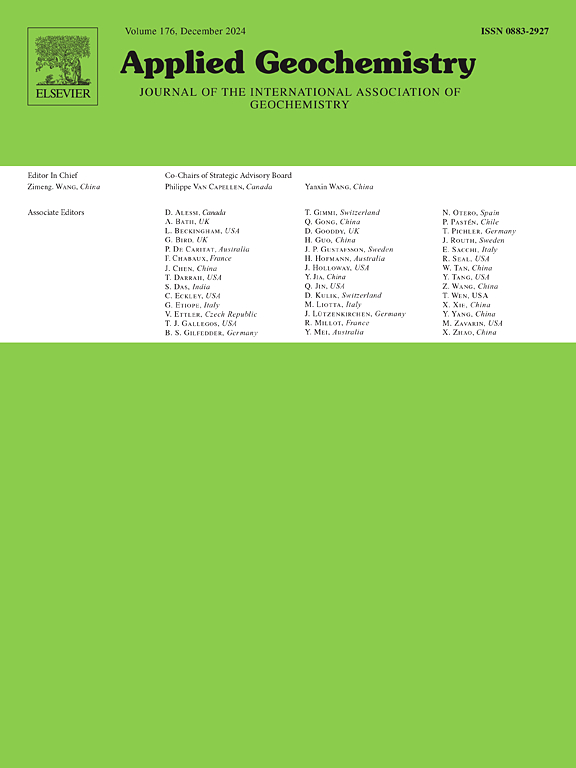Fugitive dust from exposed tailings at an inactive gold mine in Québec, Canada, using the Pas-DD dust capture method
IF 3.4
3区 地球科学
Q1 GEOCHEMISTRY & GEOPHYSICS
引用次数: 0
Abstract
Fugitive mine dust (i.e., particulate emissions) is a ubiquitous waste stream at all mine sites, including active, inactive, and abandoned. Although dust emissions can reasonably be expected to diminish after the cessation of mining activities, any waste products left uncovered have the potential to continue to emit dust to the near-mine environment. In this study, we capture and characterize dust using the Pas-DD dustfall method around the inactive gold-mine site of Joutel in the Abitibi-Témiscamingue region of Québec. The site has been inactive for 30 years, during which time the tailings storage area has been left mostly uncovered, with previously unknown amounts of dust entering the near-mine environment. The quantity of dust captured by our samplers was generally low and did not exceed 0.5 mg/dm2day. Areas of the bottom ∼2 mm of the polyurethane foam (PUF) disks used as a sampling substrate in the Pas-DD method partially degraded following deployment for 284–285 days in the field, resulting in a mass loss of up to 0.57 mg/dm2day. The low dust deposition rates and variable amounts of PUF degradation precluded net mass flux of the PUF disks providing meaningful insight into spatial variability of dust deposition. In contrast, element deposition rates and quantitative mineralogy of the dust are not impacted by PUF degradation and were the most useful datasets in this low-dust setting, allowing us to distinguish background environmental dust from local anthropogenic dust sources, including the tailings as well as other activities in the area. The major (average > 5 vol%) minerals in the dust are: muscovite (21 ± 6 vol%), quartz (22 ± 16 vol%), feldspars (18 ± 4 vol%), chlorite (13 ± 3 vol%), and olivine or serpentine (5 ± 3 vol%). All of these minerals except olivine or serpentine were also common in the tailings, in similar abundance except for reduced muscovite (3.9 ± 0.6 vol% muscovite, 27 ± 7 vol% quartz, 19 ± 3 vol% feldspars, 10 ± 5 vol% chlorite). The tailings also had iron (hydr)oxides (21 ± 8 vol%) and sometimes pyrite (14 ± 19 vol%) as major minerals. The minerals that were identified as being derived mainly from the tailings site are iron (hydr)oxides, ankerite, and pyrite whereas olivine or serpentine, amphibole, calcite, and dolomite originate primarily from the background Abitibi Greenstone Belt environment. Dust with the highest proportion of tailings-sourced minerals was captured downwind of the site and decreased in abundance with distance, pointing to wind as the primary control on dust dispersion from the tailings, with other activity in the forest near the site or along the roads producing discreet dust-generating events. The captured dust contained distinctly less Fe and As than the tailings, reflecting the much lower proportion of iron (hydr)oxides and pyrite in the dust compared to the tailings. Differences in the relative proportion of minerals in the dust compared to the tailings reflect the preferential mobilization of minerals with lower density and flaky mineral habits. Overall, this study demonstrates the utility of the Pas-DD dust monitoring method in a low-dust setting and the central role that the physical properties of minerals play in the resulting dust composition.
利用Pas-DD粉尘捕获法,从加拿大quacimubec一个废弃金矿的暴露尾矿中捕获粉尘
流散矿尘(即颗粒排放物)是所有矿山现场普遍存在的废物流,包括活跃的、不活跃的和废弃的。虽然可以合理地预期在采矿活动停止后粉尘排放量会减少,但任何未开采的废料都有可能继续向矿区附近的环境排放粉尘。在这项研究中,我们使用Pas-DD降尘法在quacimbec的abitibi - tsamiscamingue地区Joutel金矿矿区周围捕获和表征粉尘。该矿场已经闲置了30年,在此期间,尾矿储存区大部分都是裸露的,以前未知的数量的灰尘进入了矿附近的环境。我们的采样器捕获的粉尘量一般较低,不超过0.5 mg/dm2day。Pas-DD方法中用作取样基质的聚氨酯泡沫(PUF)圆盘底部~ 2mm的区域在现场放置284-285天后部分降解,导致质量损失高达0.57 mg/dm2day。低粉尘沉积率和可变的PUF降解量阻碍了PUF盘的净质量通量,这为粉尘沉积的空间变异性提供了有意义的见解。相比之下,粉尘的元素沉积率和定量矿物学不受PUF降解的影响,是在低粉尘环境中最有用的数据集,使我们能够区分背景环境粉尘和当地人为粉尘源,包括尾矿以及该地区的其他活动。专业(平均>;5 vol%)的矿物有:白云母(21±6 vol%)、石英(22±16 vol%)、长石(18±4 vol%)、绿泥石(13±3 vol%)、橄榄石或蛇纹石(5±3 vol%)。除橄榄石和蛇纹石外,其余矿物均在尾矿中常见,除还原白云母(3.9±0.6 vol%)、石英(27±7 vol%)、长石(19±3 vol%)、绿泥石(10±5 vol%)外,其余矿物丰度相近。尾矿中还含有氧化铁(水)(21±8 vol%),有时含有黄铁矿(14±19 vol%)。经鉴定,主要来源于尾矿库的矿物为氧化铁、铁云母和黄铁矿,而橄榄石或蛇纹石、角闪孔、方解石和白云石主要来源于阿比提比绿岩带背景环境。尾矿源矿物比例最高的粉尘在场地的下风处被捕获,随着距离的增加而减少,这表明风是尾矿中粉尘扩散的主要控制因素,场地附近森林或道路沿线的其他活动产生了谨慎的粉尘产生事件。捕获的粉尘中铁和砷的含量明显低于尾矿,反映了粉尘中铁(氢)氧化物和黄铁矿的比例远低于尾矿。粉尘与尾矿中矿物相对比例的差异反映了低密度、片状矿物习性的矿物优先被动员。总的来说,这项研究证明了Pas-DD粉尘监测方法在低粉尘环境中的实用性,以及矿物的物理性质在产生的粉尘组成中所起的核心作用。
本文章由计算机程序翻译,如有差异,请以英文原文为准。
求助全文
约1分钟内获得全文
求助全文
来源期刊

Applied Geochemistry
地学-地球化学与地球物理
CiteScore
6.10
自引率
8.80%
发文量
272
审稿时长
65 days
期刊介绍:
Applied Geochemistry is an international journal devoted to publication of original research papers, rapid research communications and selected review papers in geochemistry and urban geochemistry which have some practical application to an aspect of human endeavour, such as the preservation of the environment, health, waste disposal and the search for resources. Papers on applications of inorganic, organic and isotope geochemistry and geochemical processes are therefore welcome provided they meet the main criterion. Spatial and temporal monitoring case studies are only of interest to our international readership if they present new ideas of broad application.
Topics covered include: (1) Environmental geochemistry (including natural and anthropogenic aspects, and protection and remediation strategies); (2) Hydrogeochemistry (surface and groundwater); (3) Medical (urban) geochemistry; (4) The search for energy resources (in particular unconventional oil and gas or emerging metal resources); (5) Energy exploitation (in particular geothermal energy and CCS); (6) Upgrading of energy and mineral resources where there is a direct geochemical application; and (7) Waste disposal, including nuclear waste disposal.
 求助内容:
求助内容: 应助结果提醒方式:
应助结果提醒方式:


